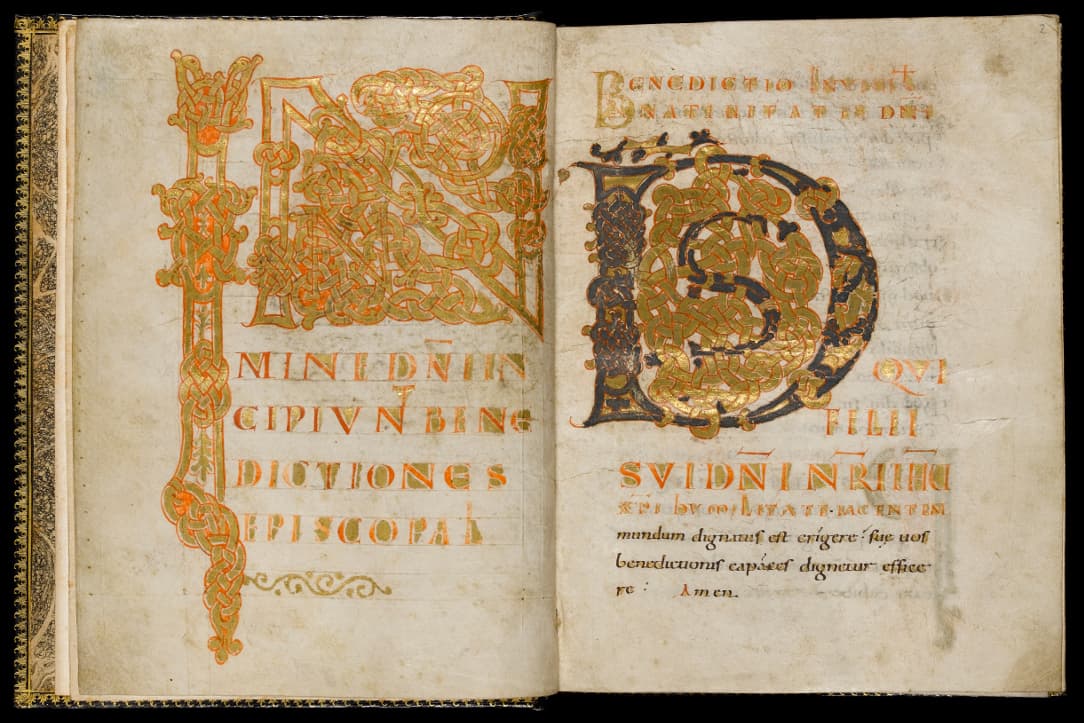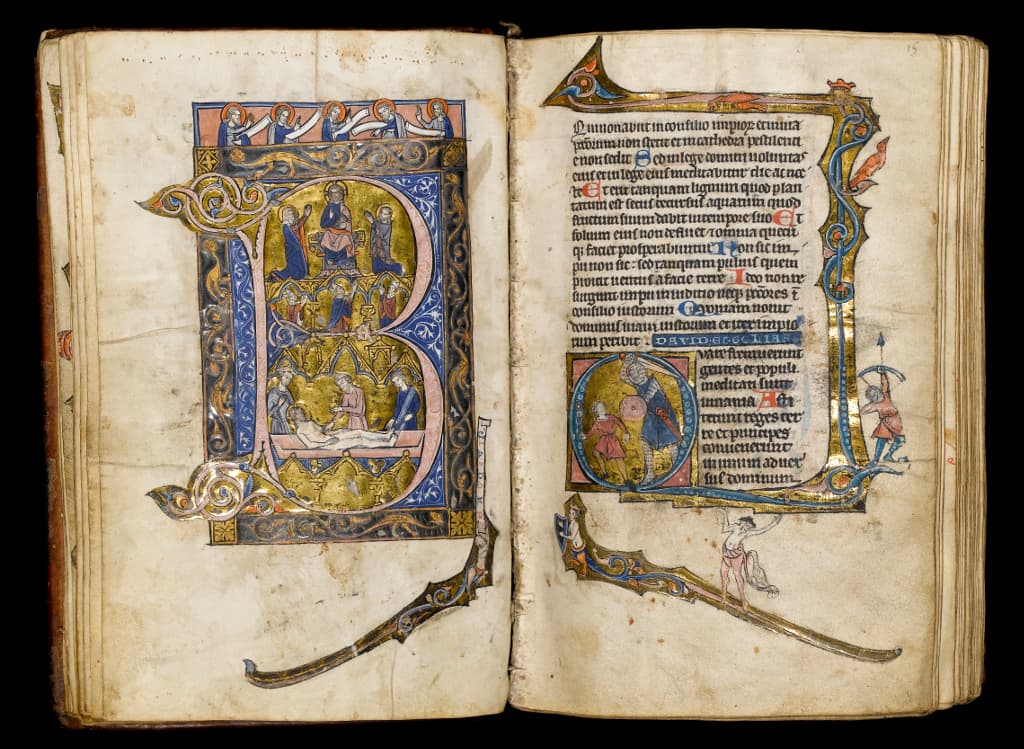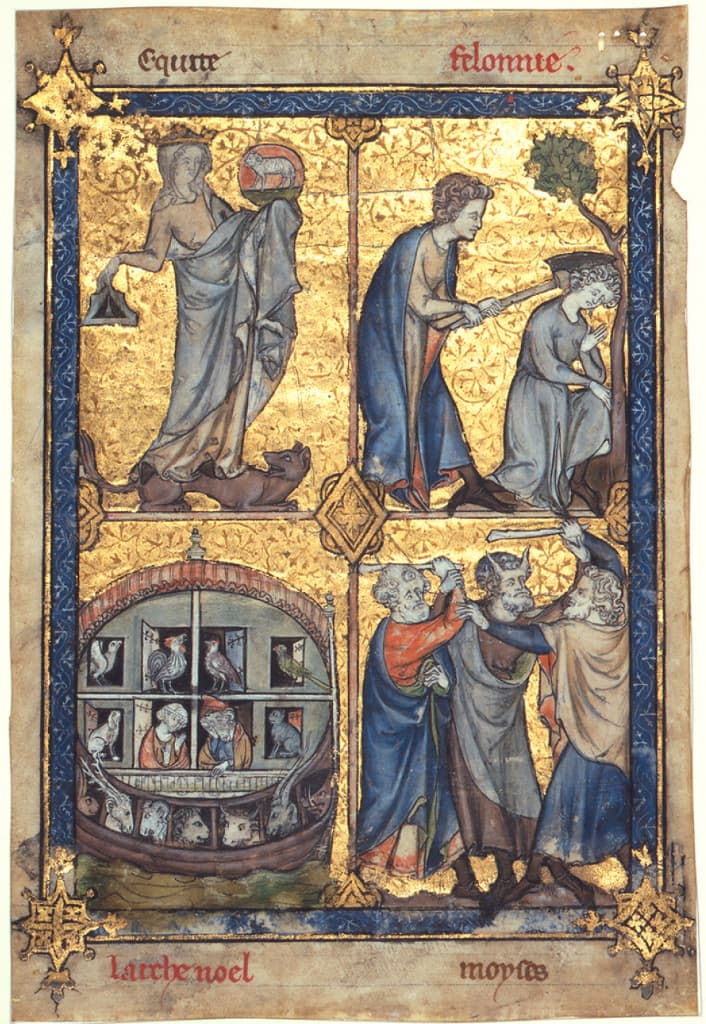Manuscripts were illuminated – literally and metaphorically – by gold and silver. The precious metals dazzled the eyes and embodied the most mysterious of God’s creations – light. They were employed in two main forms. The first – shell gold or silver – was powdered metal, mixed with glue, stored in shells and applied like paint. The second – gold or silver leaf – was metal hammered into tissue-thin sheets, laid on the page and often polished to a brilliant shine. Gold surfaces could be enhanced further with incised or drawn patterns. Shell gold was used to paint backgrounds, outline nocturnal landscapes and highlight draperies, hair or flesh. Less frequently used than gold, silver was favoured for the depiction of armour. To reduce costs and achieve diverse effects of light and texture, artists also employed brass, metallic tin and an imitation gold known as ‘mosaic gold.’

Blessings for Christmas Eve
Benedictional
East Frankish Kingdom, Augsburg or St Gall, c.925-975
Gleaming with silver and gold, these initials evoke spiritual riches, appropriate for a book of blessings. They would have shone with particular intensity during services, when the manuscript, open on a lectern, was illuminated by the warm glow of lamps and candles. The letters were painted with shell gold and silver. The gold paint contains powdered bronze and the silver has traces of a copper alloy. Shell gold was also used within the red capitals of the text’s opening words. But the larger gold areas on the right-hand page were created with pieces of gold leaf instead.
Cat. 40 - Fitzwilliam Museum, MS 27, fols. 1v-2r
Purchased in 1889

Christ blessing, Entombment, David and Goliath Psalter and Offices Meuse region, Liège, c.1280-1290
The woman who commissioned this manuscript belonged to the Béguines, an order of lay nuns devoted to charity. She was wealthy enough to afford a book whose pages gleam with silver and gold. The backgrounds on both pages are gold leaf laid on a black base and polished to a brilliant shine. The hybrids with coiling tails in the frames on the left are also gold leaf, but applied on a reddish base, left unburnished and set against backgrounds of shell silver. The ornament in the frame’s corners was painted with shell gold, creating a matt effect.
Cat. 42 - Fitzwilliam Museum, MS 288, fols. 14v-15r
Bequeathed by Rev. E.S. Dewick in 1917

Entry into Jerusalem Initial D from a Gradual; Italy, Venice, c.1410-1420
The prolific Venetian artist Cristoforo Cortese employed three metals in this image. The background is burnished gold leaf tooled with punched dots. Adding a pleasing texture to the image and permitting light to play on its surface, the tooling creates the impression of divine radiance illuminating the city of Jerusalem as Christ enters. Cortese highlighted Christ’s red robe in shell gold. He used mosaic gold, a bronze-coloured powder made of tin sulphide, for the robe of the bearded apostle at the far left, and for the feathery foliage and beads that decorate the blue initial.
Cat. 47 - Fitzwilliam Museum, Marlay cutting It. 20
Bequeathed by Charles Brinsley Marlay in 1912

Equity and Felony Leaf from Laurent d’Orléans, La Somme le roi
France, Paris, c.1290-1295 Artist: Master Honoré d’Amiens (documented 1289-1312)
The stories of Noah’s Ark and Moses restraining angry men illustrate the virtue of Equity (top left), while the vice of Felony is represented by Cain’s murder of Abel (top right). The image belonged to a manual on moral conduct made for Philip IV of France (1285-1314) and his queen, Jeanne of Navarre. It was illuminated by the foremost Parisian artist of the time, Master Honoré. He used three metals: gold leaf for the background, with delicate motifs painted over it; shell gold for the frame and central quatrefoil; and silver for Cain’s shovel.
Cat. 49 - Fitzwilliam Museum, MS 192
Given by Samuel Sanders in 1892




